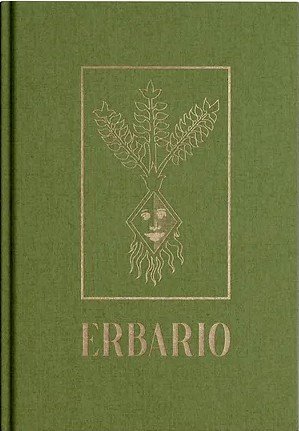Erbario (forthcoming)
1st Edition limited to 700 hand numbered copies
Erbario is a large and extraordinary illustrated herbal created in Italy around 1400.
This manuscript stands out for its unique combination of about 180 botanical illustrations and textual annotations, offering a rich glimpse into medieval and early Renaissance knowledge of plants and their medicinal uses. It features three distinct styles of illustration, each contributing to the manuscript’s layered and evolving character.
The first group of illustrations, found on the recto pages through most of the manuscript, adheres to traditional medieval artistic conventions. These images often incorporate fantastical elements, such as plants with human faces, blending scientific intent with folklore and imagination. A second group of illustrations, rendered in ink outlines, is rougher in execution but shows a shift toward more naturalistic depictions. These drawings are located on verso pages or added alongside earlier color illustrations, suggesting they were added later to complement or correct the existing artwork. The third group consists of highly naturalistic, colored illustrations that focus on detailed representations of plants, including their roots, leaves, flowers, and fruit. These more accurate depictions, often found on verso pages, reflect the growing Renaissance interest in careful observation and the natural sciences.
Approximately a quarter of the illustrations are paired with annotations that discuss the medicinal properties and preparation methods for the plants. These notes, written in the same ink as the ink outline drawings, are mostly in Italian, indicating that the manuscript was likely created in the Veneto region. However, occasional use of Latin or a mix of both languages suggests an audience that may have included scholars or clergy. The annotations are seamlessly integrated into the illustrations, written around and sometimes over the images, demonstrating the manuscript’s use as a practical and working text.
This herbal embodies a fascinating blend of artistic traditions, scientific inquiry, and cultural influences. Its combination of medieval conventions, emerging naturalistic styles, and bilingual annotations reflects a transitional period in botanical study, bridging the medieval and Renaissance eras.
The manuscript, written in a mix of Latin and Veneto-Italian poses unique challenges. Parts of the text are fragmentary, with faded or missing sections, inconsistent spellings, and unclear punctuation. The handwriting itself is occasionally difficult to decipher, leading to inevitable gaps or ambiguities in the transcription.
Where possible, the original wording and stylistic nuances have been retained, with only minimal editorial intervention to decipher indistinct passages and reconstruct punctuation for improved readability. No effort has been made to standardize or modernize the text, preserving its historical authenticity. The translations, in turn, represent careful interpretations of the readable portions and aim to remain faithful to the original’s intent, while acknowledging areas where the text is incomplete or ambiguous.
These transcripts are intended as a companion to Erbario, offering guidance through its visual and textual richness. Readers are encouraged to engage directly with the manuscript itself, as such interaction may reveal further layers of its historical and botanical significance.
DETAILS
This edition comes in a large format, measuring 215 x 310 mm (8.46 x 12.20 inches). It features a moss-green clothbound cover with gold details on the front and spine. Printed on 170 gsm paper, it includes around 180 illustrations. The facsimile contains a full transcript along with a clear, interpretative english translation.
Original Price - £76

